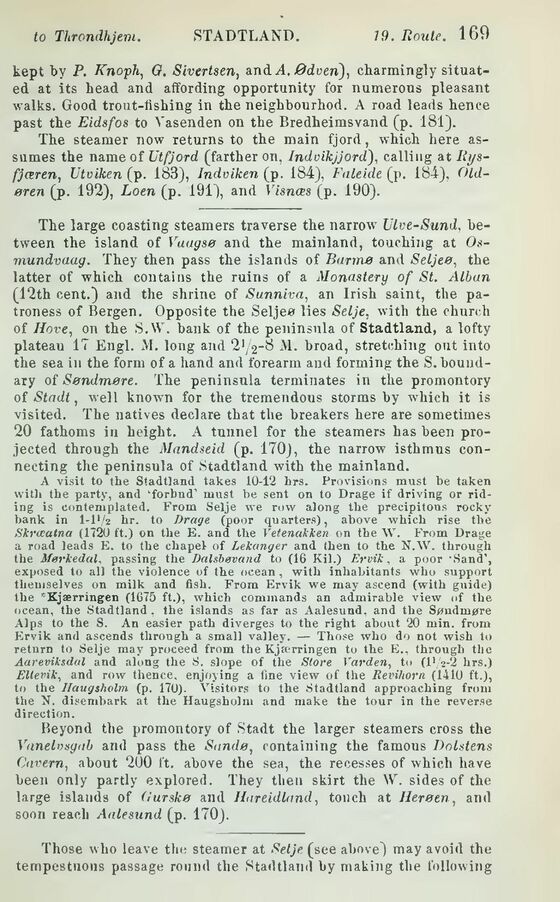
Full resolution (JPEG) - On this page / på denna sida - Norway - Pages ...

<< prev. page << föreg. sida << >> nästa sida >> next page >>
Below is the raw OCR text
from the above scanned image.
Do you see an error? Proofread the page now!
Här nedan syns maskintolkade texten från faksimilbilden ovan.
Ser du något fel? Korrekturläs sidan nu!
This page has never been proofread. / Denna sida har aldrig korrekturlästs.
kept by P. Knoph, 0. Sivertsen, and A.Ødven), charmingly
situated at its head and affording opportunity for numerous pleasant
walks. Good trout-fishing in the neighbourhod. A road leads hence
past the Eidsfos to Väsenden on the Bredheimsvand (p. 181).
The steamer now returns to the main fjord, which here
assumes the name of Utfjord (farther on, Indvikjjord’), calling at
Rt/s-fjceren, Utviken (p. 183), Jndviken (p. 184), Faleide (p. 184),
Olderen (p. 192), Loen (p. 191), and Visnces (p. 190).
The large coasting steamers traverse the narrow Ulve-Sund,
between the island of Vuagse and the mainland, touching at
Os-mundvaag. They then pass the islands of Barme and Seljee, the
latter of which contains the ruins of a Monastery of St. Alban
(12th cent.) and the shrine of Sunniva, an Irish saint, the
patroness of Bergen. Opposite the Seljeø lies Selje, with the church
of Hove, on the S.W. bank of the peninsula of Stadtland, a lofty
plateau IT Engl. M. long and 21 ’2-8 M. broad, stretching out into
the sea in the form of a hand and forearm and forming the S.
boundary of Sendmere. The peninsula terminates in the promontory
of Stadt, well known for the tremendous storms by which it is
visited. The natives declare that the breakers here are sometimes
20 fathoms in height. A tnnnel for the steamers has been
projected through the Mandseid (p. 170), the narrow isthmus
connecting the peninsula of Stadtland with the mainland.
A visit to the Stadtland takes 10-12 hrs. Provisions must be taken
with the party, and ‘forbnd’ must be sent on to Drage if driving or
riding is contemplated. From Selje we row along the precipitous rocky
bank in l-l*/2 hr. to Drage (poor quarters), above which rise the
Skræatna (1720 ft.) on the E. and the Vetenakken on the W. From Drage
a road leads E. to the chapel of Lekanger and then to the 17.W. through
the Merkedal, passing the Dalsbevand to (16 Kil.) Ervik, a poor -Sand’,
exposed to all the violence of the ocean, with inhabitants who support
themselves on milk and fish. From Ervik we may ascend (with guide)
the "Kjaerringen (1675 ft.), which commands an admirable view of the
ocean, the Stadtland , the islands as far as Aalesund, and the Søndmøre
Alps to the S. An easier path diverges to the right about 20 min. from
Ervik and ascends through a small valley. — Those who do not wish to
return to Selje may proceed from the Kjærringen to the E.. through the
Aareviksdal and along the S. slope of the Store Varden, to (l1 2-2 hrs.)
Eltevik, and row thence, enjoying a fine view of the Revihorn (1410 ft.),
to the Ifaugsholm. (p. 170). Visitors to the Stadtland approaching from
the 77. disembark at the Haugsholm and make the tour in the reverse
direction.
Beyond the promontory of Stadt the larger steamers cross the
Vanelvsgal and pass the Sande, containing the famous Dolstens
Cavern, about 2U0 ft. above the sea, the recesses of which have
been only partly explored. They then skirt the W. sides of the
large islands of (lurske and Hareidland, touch at Ilereen, and
soon reach Aalesund (p. 170).
Those who leave the steamer at Selje (see above) may avoid the
tempestuous passage round the Stadtland by making the following
<< prev. page << föreg. sida << >> nästa sida >> next page >>